Optimization of Data-Driven Soil Temperature Forecast—The First Model in Bangladesh
Abstract
:1. Introduction
2. Machine Learning Models
3. Study Region and Data
4. Forecast Experiment Design
- ➢
- Three types of lead times: one day, three days, and five days.
- ➢
- Five sizes of time window: one day, two days, three days, four days, and five days.
- ➢
- Eight combinations of daily minimum temperature (MIN), i.e., daily maximum temperature (MAX), daily mean temperature (MEAN), daily sunshine duration (SUN), daily rainfall (RAIN), and daily humidity (HUM), were used as model inputs. In particular, the combinations were as follows: (1) MEAN, (2) MEAN-SUN, (3) MEAN-MAX-MIN, (4) MEAN-HUM-RAIN, (5) MEAN-MAX-MIN-SUN, (6) MEAN-MAX-MIN-SUN-RAIN, (7) MEAN-MAX-MIN-SUN-HUM, and (8) MEAN-MAX-MIN-SUN-HUM-RAIN.
5. Results and Discussion
5.1. Forecasting Soil Temperature at 10 cm Depth in Bangladesh
5.1.1. One-Day Lead-Time Forecast
5.1.2. Three-Day Lead-Time Forecast
5.1.3. Five-Day Lead-Time Forecast
5.2. Forecasting Soil Temperature at 30 cm Depth in Bangladesh
5.2.1. One-Day Lead-Time Forecast
5.2.2. Three-Day Lead-Time Forecast
5.2.3. Five-Day Lead-Time Forecast
5.3. Forecasting Soil Temperature at 50 cm Depth in Bangladesh
5.3.1. One-Day Lead-Time Forecast
5.3.2. Three-Day Lead-Time Forecast
5.3.3. Five-Day Lead-Time Forecast
6. Conclusions
Author Contributions
Funding
Institutional Review Board Statement
Informed Consent Statement
Data Availability Statement
Conflicts of Interest
References
- Hu, G.; Zhao, L.; Wu, X.; Li, R.; Wu, T.; Xie, C.; Qiao, Y.; Shi, J.; Cheng, G. An analytical model for estimating soil temperature profiles on the Qinghai-Tibet plateau of China. J. Arid. Land. 2016, 8, 232–240. [Google Scholar] [CrossRef]
- Yan, Y.; Yan, R.; Chen, J.; Xin, X.; Eldridge, D.J.; Shao, C.; Wang, X.; Lv, S.; Jin, D.; Chen, J.; et al. Grazing modulates soil temperature and moisture in a Eurasian steppe. Agric. For. Meteorol. 2018, 262, 157–165. [Google Scholar] [CrossRef]
- Kandasamy, J.; Xue, Y.; Houser, P.; Maggioni, V. Performance of Different Crop Models in Simulating Soil Temperature. Sensors 2023, 23, 2891. [Google Scholar] [CrossRef] [PubMed]
- Seyfried, M.S.; Flerchinger, G.N.; Murdock, M.D.; Hanson, C.L.; Van Vactor, S. Long-term soil temperature database, Reynolds Creek experimental watershed, Idaho, United States. Water Resour. Res. 2001, 37, 2843–2846. [Google Scholar] [CrossRef]
- Qi, J.; Zhang, X.; Cosh, M.H. Modeling soil temperature in a temperate region: A comparison between empirical and physically based methods in SWAT. Ecol. Eng. 2019, 129, 134–143. [Google Scholar] [CrossRef]
- Gharabaghi, B.; Safadoust, A.; Mahboubi, A.; Mosaddeghi, M.; Unc, A.; Ahrens, B.; Sayyad, G. Temperature effect on the transport of bromide and E. coli NAR in saturated soils. J. Hydrol. 2015, 522, 418–427. [Google Scholar] [CrossRef]
- Tenge, A.; Kaihura, F.B.; Lal, R.; Singh, B. Diurnal soil temperature fluctuations for different erosion classes of an oxisol at Mlingano, Tanzania. Soil Tillage Res. 1998, 49, 211–217. [Google Scholar] [CrossRef]
- Sanikhani, H.; Deo, R.C.; Yaseen, Z.M.; Eray, O.; Kisi, O. Non-tuned data intelligent model for soil temperature estimation: A new approach. Geoderma 2018, 330, 52–64. [Google Scholar] [CrossRef]
- Holmes, T.R.H.; Owe, M.; De-Jeu, R.A.M.; Kooi, H. Estimating the soil temperature profile from a single depth observation: A simple empirical heat flow solution. Water Resour. Res. 2008, 44, W02412. [Google Scholar] [CrossRef]
- Albergel, C.; Dutra, E.; Muñoz-Sabater, J.; Haiden, T.; Balsamo, G.; Beljaars, A.; Isaksen, L.; de Rosnay, P.; Sandu, I.; Wedi, N. Soil temperature at ECMWF: An assessment using ground-based observations. J. Geophys. Res. Atmos. 2015, 120, 1361–1373. [Google Scholar] [CrossRef]
- Li, K.; Zhang, J.; Wu, L.; Yang, K.; Li, S. The role of soil temperature feed backs for summer air temperature variability under climate change over East Asia. Earth’s Future 2022, 10, e2021EF002377. [Google Scholar] [CrossRef]
- Song, Y.; Huang, A.; Chen, H. The Persistence and Reemergence of Atmospheric Anomaly Signals in Soil Temperature. J. Geophys. Res. Atmos. 2022, 127, e2022JD037218. [Google Scholar] [CrossRef]
- Di Salvo, C. Improving Results of Existing Groundwater Numerical Models Using Machine Learning Techniques: A Review. Water 2022, 14, 2307. [Google Scholar] [CrossRef]
- Chen, C.; Zhang, H.; Shi, W.; Zhang, W.; Xue, Y. A novel paradigm for integrating physics-based numerical and machine learning models: A case study of eco-hydrological model. Environ. Model. Softw. 2023, 163, 105669. [Google Scholar] [CrossRef]
- Bhagat, S.K.; Tung, T.M.; Yaseen, Z.M. Development of artificial intelligence for modeling waste water heavy metal removal: State of the art, application assessment and possible future research. J. Clean. Prod. 2020, 250, 119473. [Google Scholar] [CrossRef]
- Tung, T.M.; Yaseen, Z.M. A survey on river water quality modelling using artificial intelligence models: 2000–2020. J. Hydrol. 2020, 585, 124670. [Google Scholar]
- Zhang, Z.; Li, J. Big Data Mining for Climate Change; Elsevier: Amsterdam, The Netherlands, 2020. [Google Scholar]
- Schmidt, L.; Heße, F.; Attinger, S.; Kumar, R. Challenges in Applying Machine Learning Models for Hydrological Inference: A Case Study for Flooding Events Across Germany. Water Resour. Res. 2020, 56, e2019WR025924. [Google Scholar] [CrossRef]
- Okkan, U.; Ersoy, Z.B.; Kumanlioglu, A.A.; Fistikoglu, O. Embedding machine learning techniques into a conceptual model to improve monthly runoff simulation: A nested hybrid rainfall-runoff modeling. J. Hydrol. 2021, 598, 126433. [Google Scholar] [CrossRef]
- Alam, S.S.; Islam, A.J.; Hasan, M.M.; Rafid, M.N.M.; Chakma, N.; Imtiaz, M.N. Design and development of a low-cost IoT based environmental pollution monitoring system. In Proceedings of the 2018 4th International Conference on Electrical Engineering and Information & Communication Technology (iCEEiCT), Dhaka, Bangladesh, 13–15 September 2018; pp. 652–656. [Google Scholar]
- Uddin, M.S.; Istiaq, F.; Rasadin, M.; Talukder, R. Freshwater shrimp farm monitoring system for Bangladesh based on internet of things. Eng. Rep. 2020, 2, e12184. [Google Scholar] [CrossRef]
- Hasan, M.S.; Khandaker, S.; Iqbal, M.S.; Kabir, M.M. A real-time smart wastewater monitoring system using IoT: Perspective of Bangladesh. In Proceedings of the 2020 2nd International Conference on Sustainable Technologies for Industry 4.0 (STI), Dhaka, Bangladesh, 19–20 December 2020; pp. 1–6. [Google Scholar]
- Pathak, A.; AmazUddin, M.; Abedin, J.; Andersson, K.; Mustafa, R.; Hossain, M.S. IoT based Smart System to Support Agricultural Parameters: A Case Study. Procedia Comput. Sci. 2019, 155, 648–653. [Google Scholar] [CrossRef]
- Placidi, P.; Morbidelli, R.; Fortunati, D.; Papini, N.; Gobbi, F.; Scorzoni, A. Monitoring Soil and Ambient Parameters in the IoT Precision Agriculture Scenario: An Original Modeling Approach Dedicated to Low-Cost Soil Water Content Sensors. Sensors 2021, 21, 5110. [Google Scholar] [CrossRef] [PubMed]
- Morais, R.; Mendes, J.; Silva, R.; Silva, N.; Sousa, J.J.; Peres, E. A Versatile, Low-Power and Low-Cost IoT Device for Field Data Gathering in Precision Agriculture Practices. Agriculture 2021, 11, 619. [Google Scholar] [CrossRef]
- Muangprathub, J.; Boonnam, N.; Kajornkasirat, S.; Lekbangpong, N.; Wanichsombat, A.; Nillaor, P. IoT and agriculture data analysis for smart farm. Comput. Electron. Agric. 2018, 156, 467–474. [Google Scholar] [CrossRef]
- Suanpang, P.; Jamjuntr, P. A Smart Farm Prototype with an Internet of Things (IoT) Case Study: Thailand. J. Adv. Agric. Technol. 2019, 6. Available online: http://www.joaat.com/uploadfile/2019/1220/20191220115115540 (accessed on 20 November 2023). [CrossRef]
- Zounemat-Kermani, M. Hydrometeorological Parameters in Prediction of Soil Temperature by Means of Artificial Neural Network: Case Study in Wyoming. J. Hydrol. Eng. 2013, 18, 707–718. [Google Scholar] [CrossRef]
- Aslay, F.; Ozen, U. Estimating Soil Temperature with Artificial Neural Networks Using Meteorological Parameters. J. Polytech. 2013, 16, 139–145. [Google Scholar]
- Yener, D.; Ozgener, O.; Ozgener, L. Prediction of soil temperatures for shallow geothermal applications in Turkey. Renew. Sustain. Energy Rev. 2017, 70, 71–77. [Google Scholar]
- Sattari, M.T.; Avram, A.; Apaydin, H.; Matei, O. Soil Temperature Estimation with Meteorological Parameters by Using Tree-Based Hybrid Data Mining Models. Mathematics 2020, 8, 1407. [Google Scholar] [CrossRef]
- IPCC. Summary for policymakers. In Climate Change 2013: The Physical Science Basis, Contribution of Working Group I to the Fifth Assessment Report of the Intergovernmental Panel on Climate Change; Cambridge University Press: Cambridge, UK; New York, NY, USA, 2013; pp. 3–29. [Google Scholar]
- Harmeling, S. Global Climate Risk Index 2009: Weather-related loss and their impacts on countries in 2007 and in a long term comparison. In Global Climate Risk Index; Germanwatch e.V. Publishing: Berlin, Germany, 2009. [Google Scholar]
- Islam, K.I.; Khan, A.; Islam, T. Correlation between Atmospheric Temperature and Soil Temperature: A Case Study for Dhaka, Bangladesh. Atmos. Clim. Sci. 2015, 5, 200–208. [Google Scholar] [CrossRef]
- Hastie, T.; Tibshirani, R.; Friedman, J. The Elements of Statistical Learning: Data Mining, Inference, and Prediction; Springer Science & Business Media: Berlin/Heidelberg, Germany, 2009. [Google Scholar]
- Sun, H.; Gui, D.; Yan, B.; Liu, Y.; Liao, W.; Zhu, Y.; Lu, C.; Zhao, N. Assessing the potential of random forest method for estimating solar radiation using air pollution index. Energy Convers. Manag. 2016, 119, 121–129. [Google Scholar] [CrossRef]
- Rad, M.R.P.; Toomanian, N.; Khormali, F.; Brungard, C.W.; Komaki, C.B.; Bogaert, P. Updating soil survey maps using random forest and conditioned Latin hypercube sampling in the loess derived soils of northern Iran. Geoderma 2014, 232–234, 97–106. [Google Scholar]
- Breiman, L.; Friedman, J.; Stone, C.J.; Olshen, R.A. Classification and Regression Trees; CRC Press: Boca Raton, FL, USA, 1984. [Google Scholar]
- Wu, Y.; Zhang, Z.; Crabbe, M.J.C.; Das, L.C. Statistical Learning-Based Spatial Downscaling Models for Precipitation Distribution. Adv. Meteorol. 2022, 2022, 3140872. [Google Scholar] [CrossRef]
- Brammer, H.; Antoine, J.; Kassam, A.H.; van Velthuizen, H.T. Land Resources Appraisal of Bangladesh for Agricultural Development. Technical Reports 1–7; BGD/81/035 Agricultural Development Advisor Project; FAO/UNDP: Dhaka, Bangladesh, 1988. [Google Scholar]
- Mukul, S.A.; Biswas, S.R.; Rashid, A.Z.M.M.; Miah, M.D.; Kabir, M.E.; Uddin, M.B.; Alamgir, M.; Khan, N.A.; Sohel, M.S.I.; Chowdhury, M.S.H.; et al. A new estimate of carbon for Bangladesh forest ecosystems with their spatial distribution and REDD+ implications. Intern. J. Res. Land-Use Sustain. 2014, 1, 33–41. [Google Scholar]
- Khan MA, S.A.; Uddin, M.B.; Uddin, M.S.; Chowdhury MS, H.; Mukul, S.A. Distribution and status of forests in the tropic: Bangladesh perspective. Proc. Pakistan Acad. Sci. 2007, 44, 145–153. [Google Scholar]
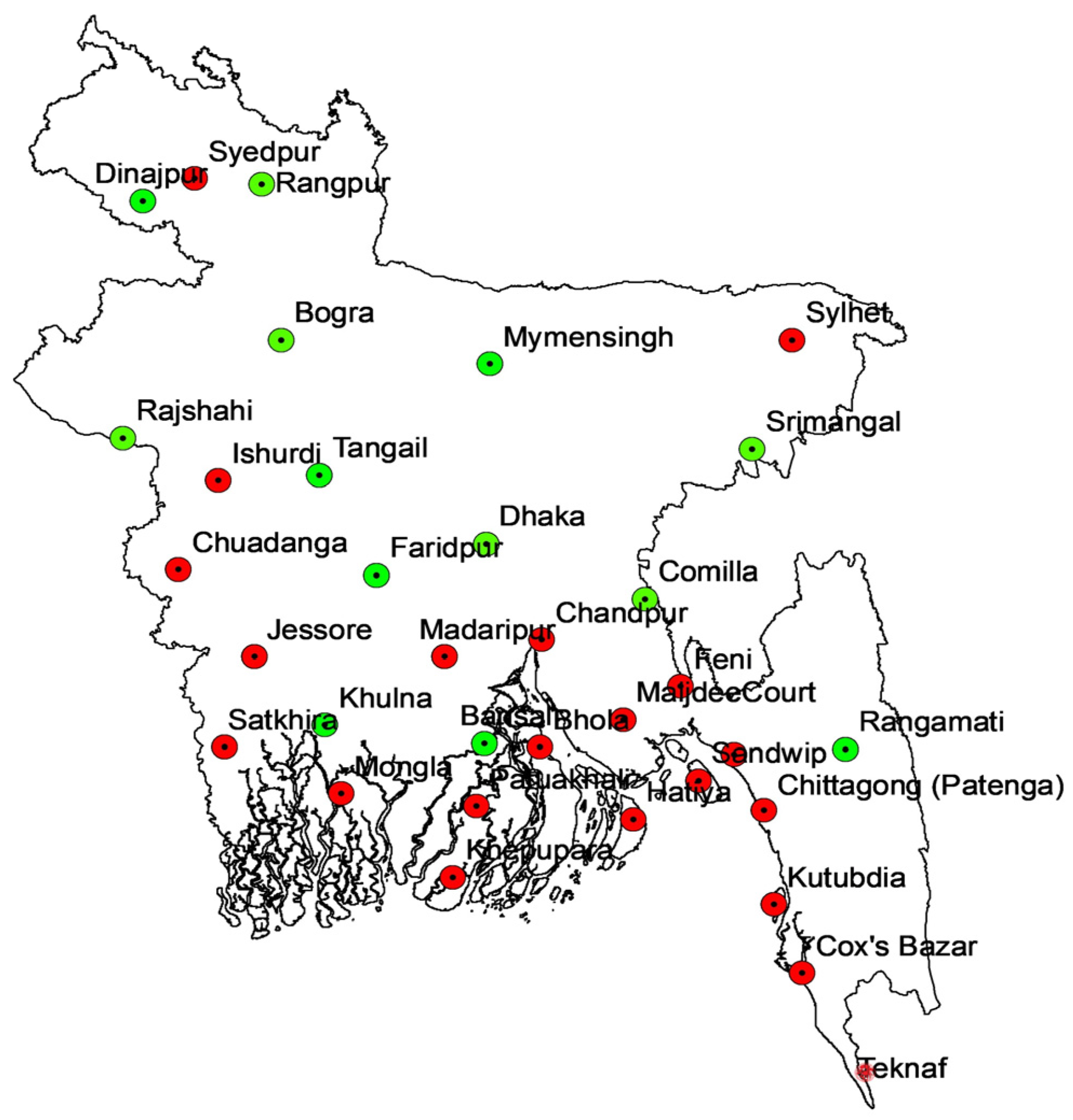
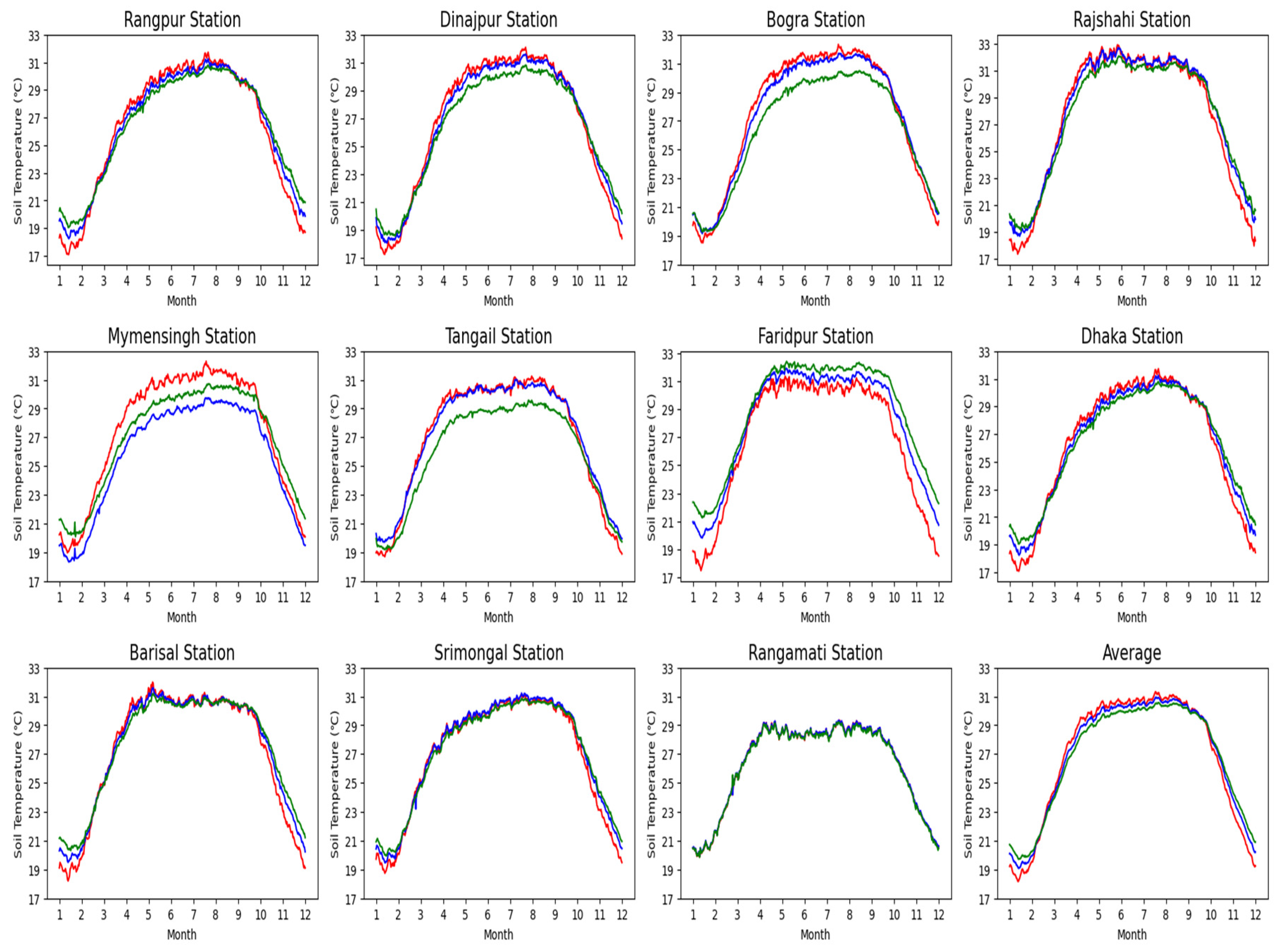
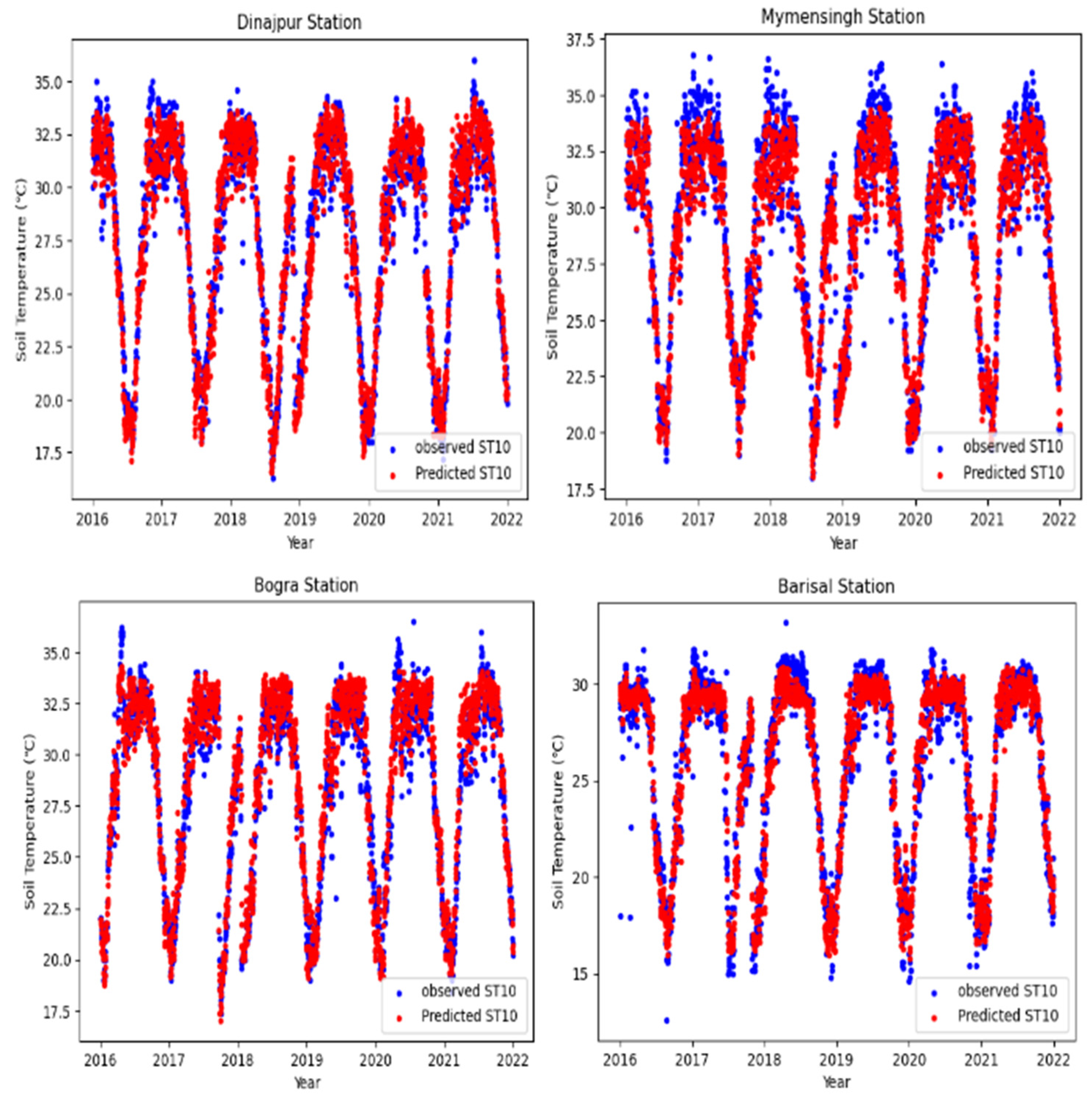
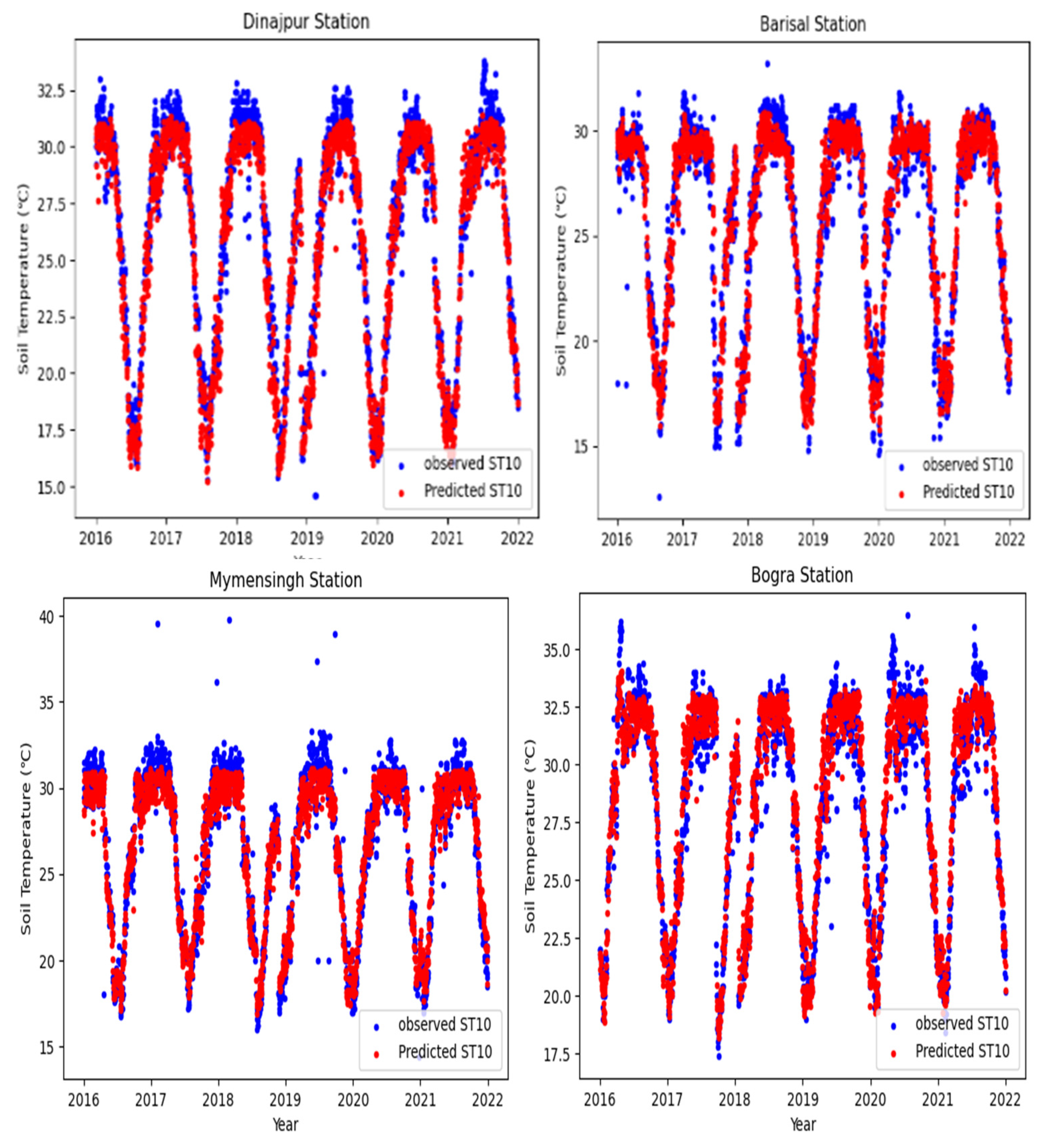
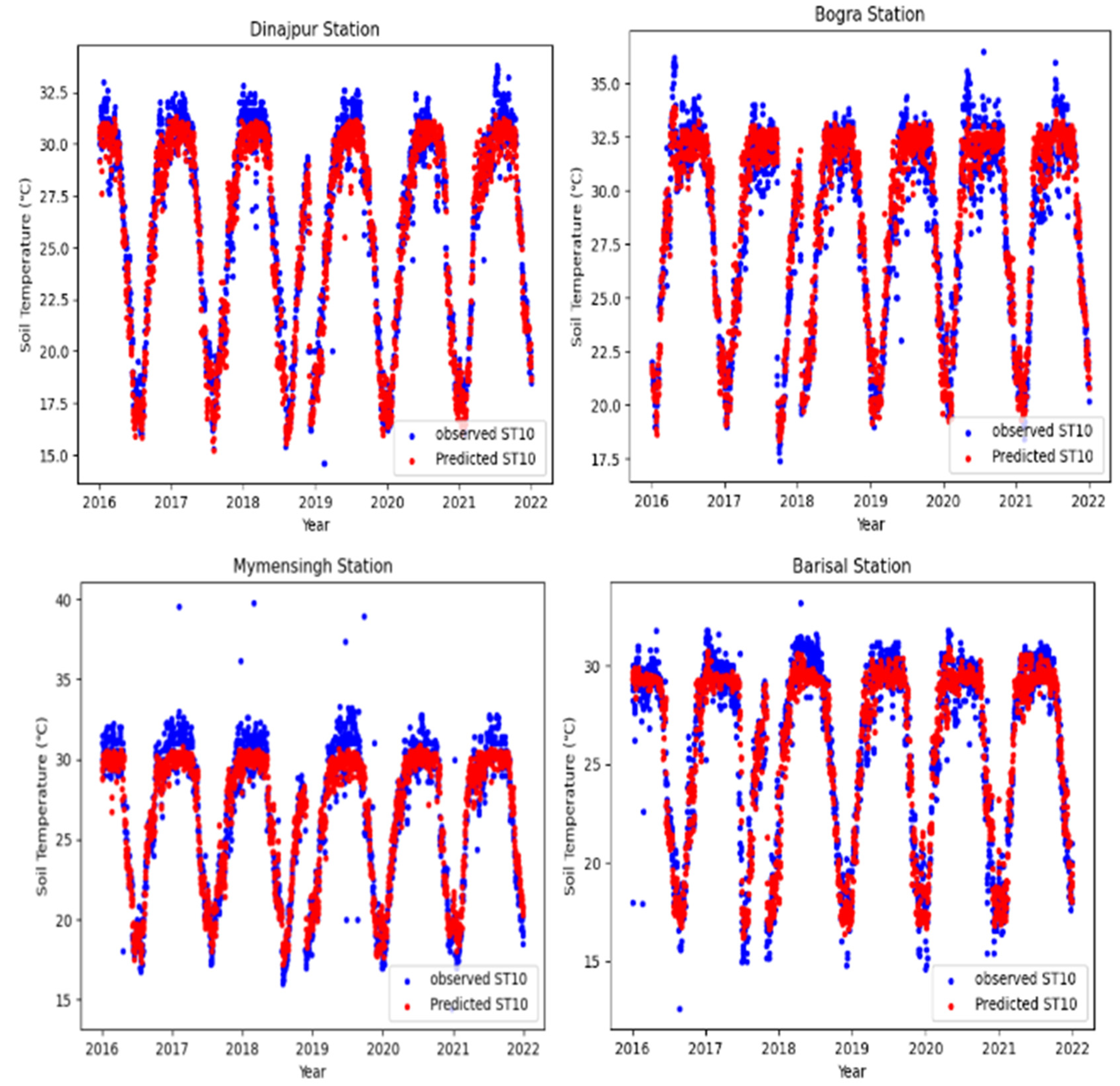
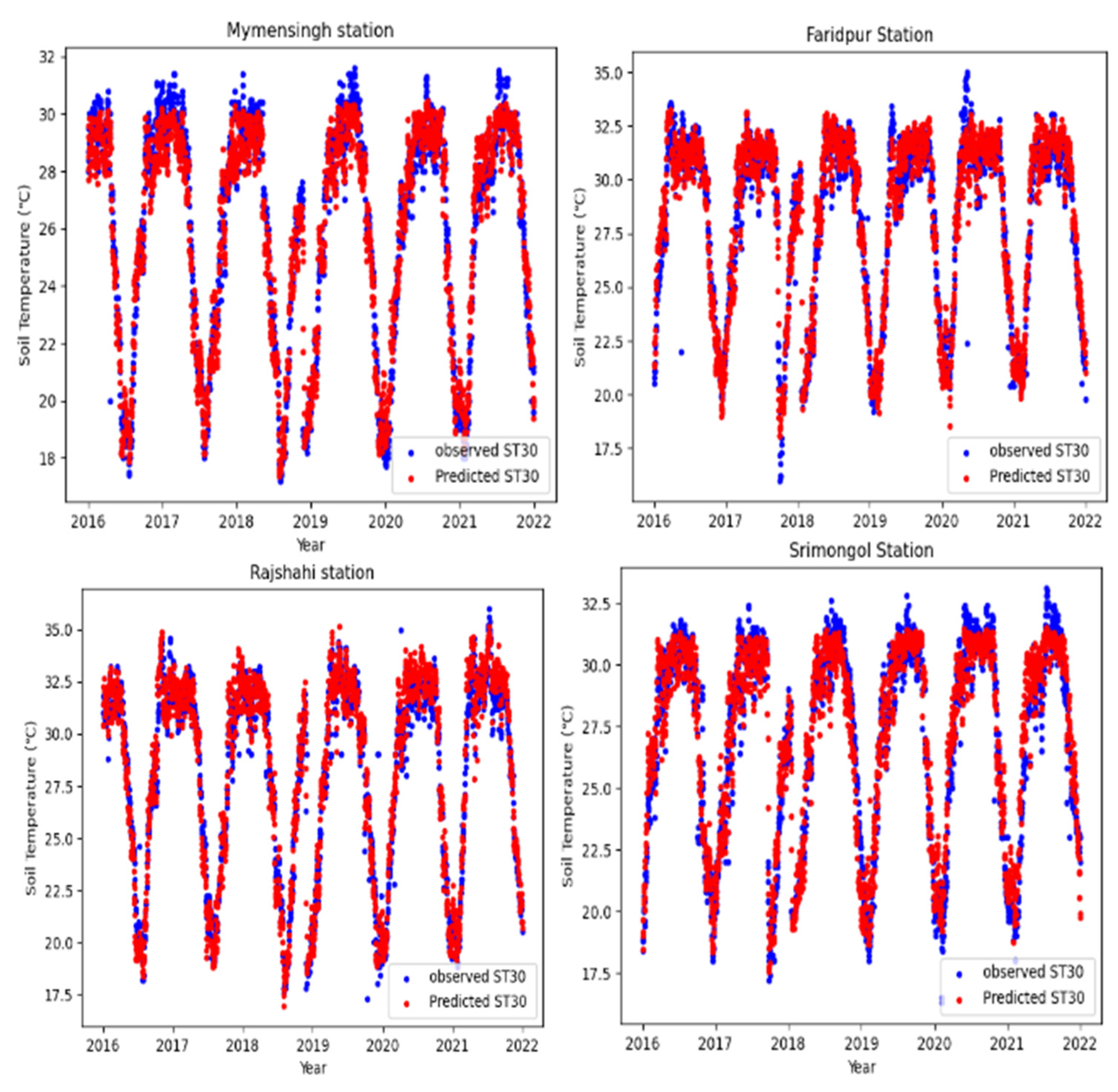
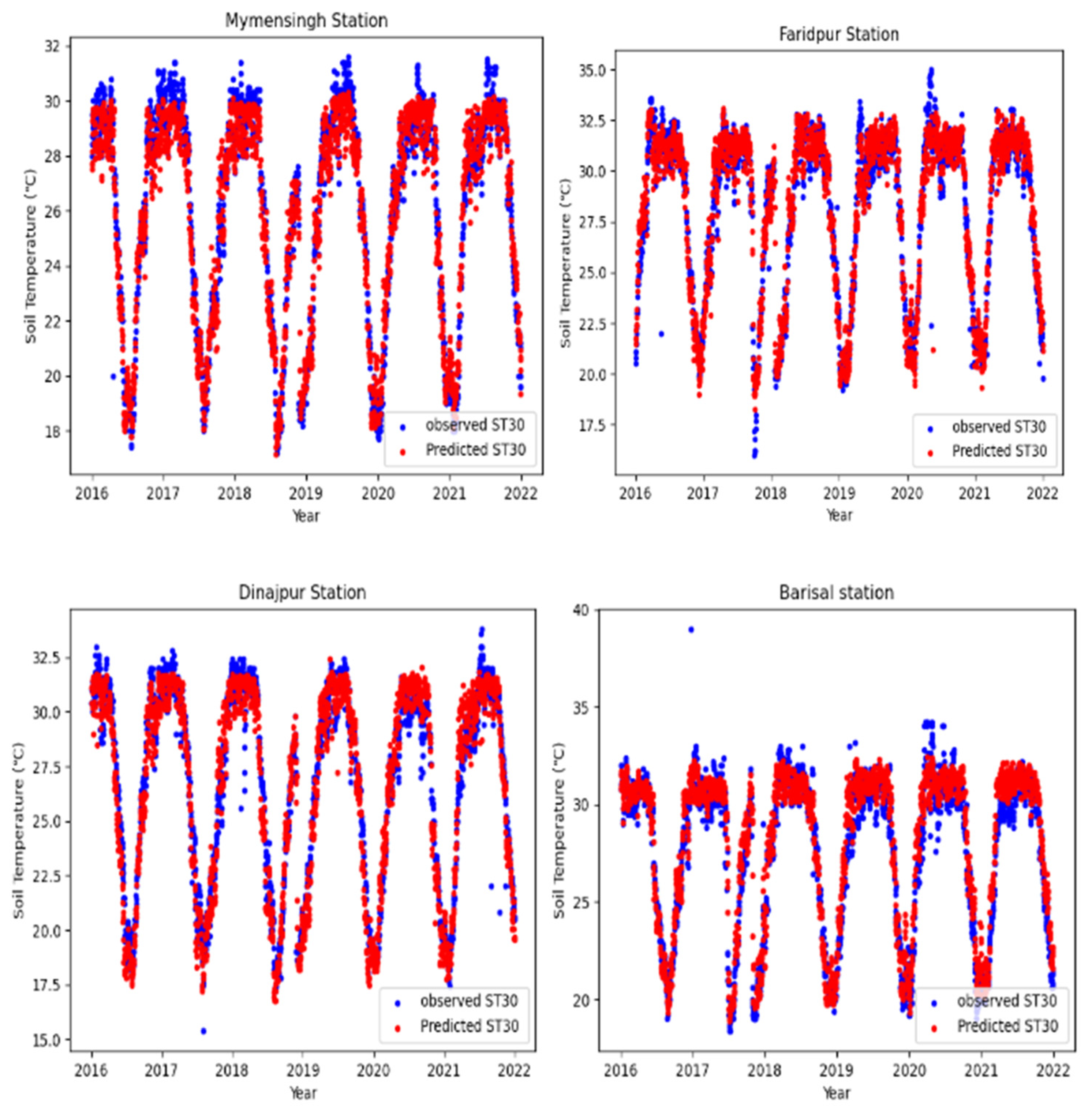
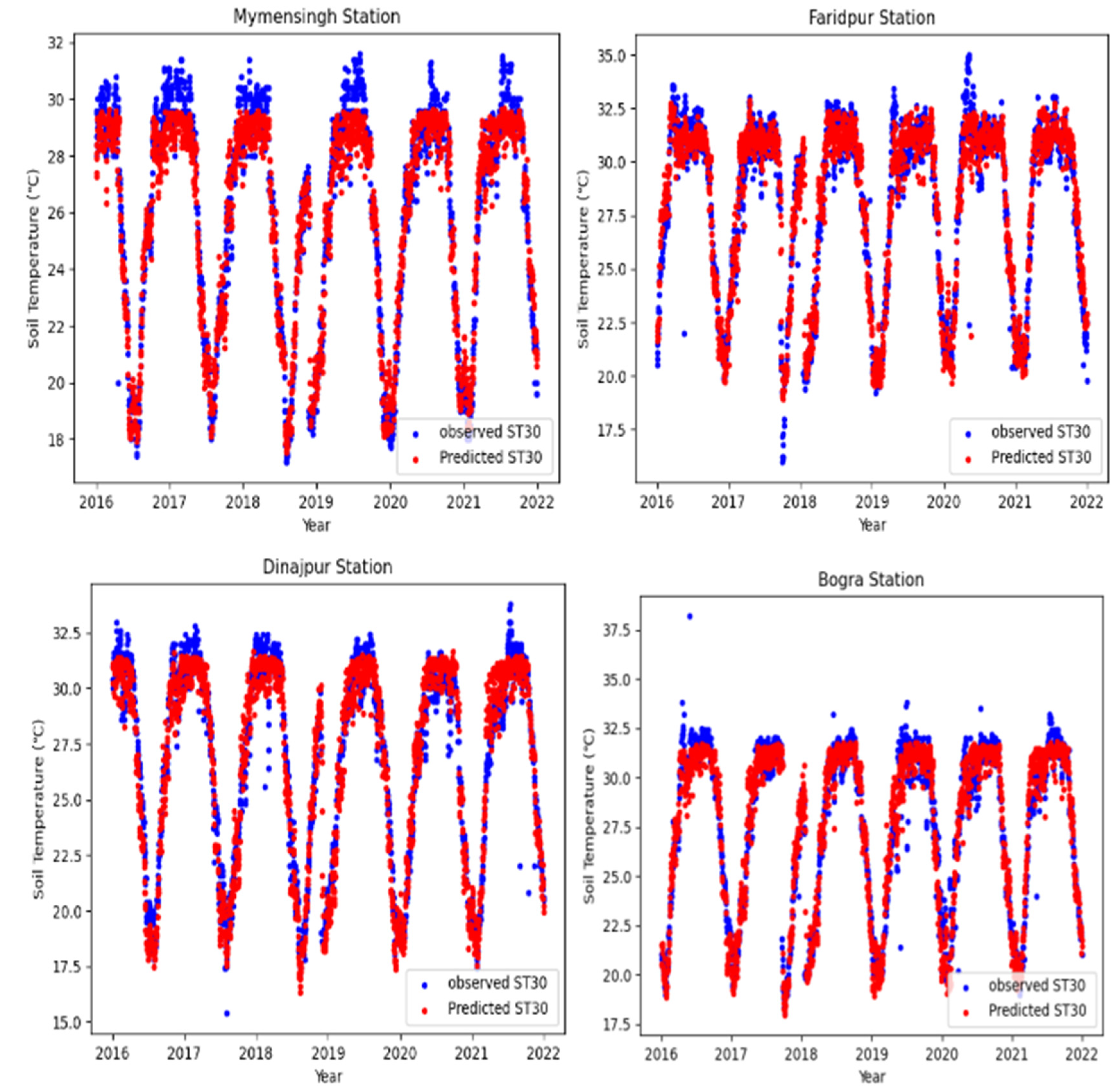
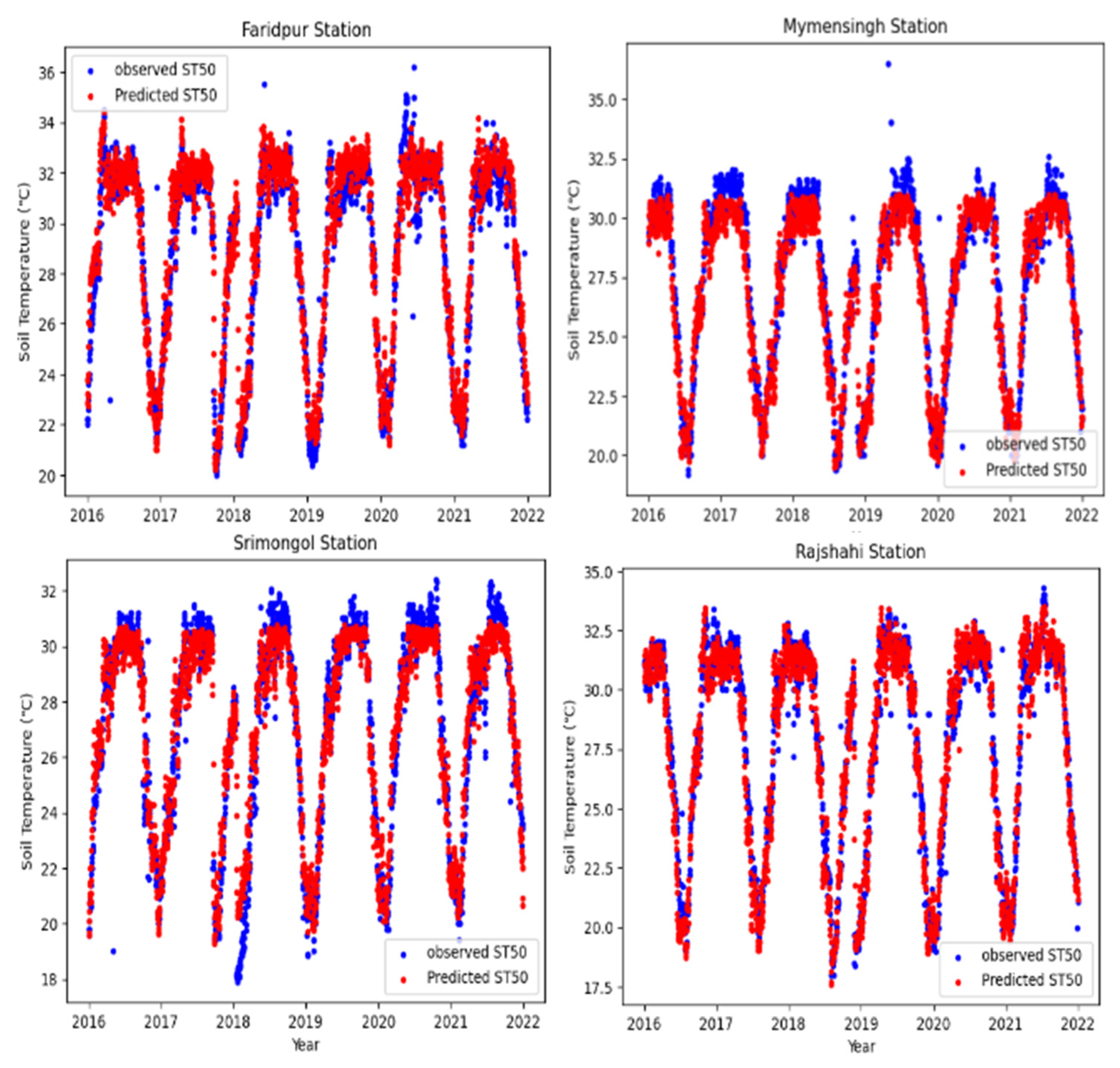
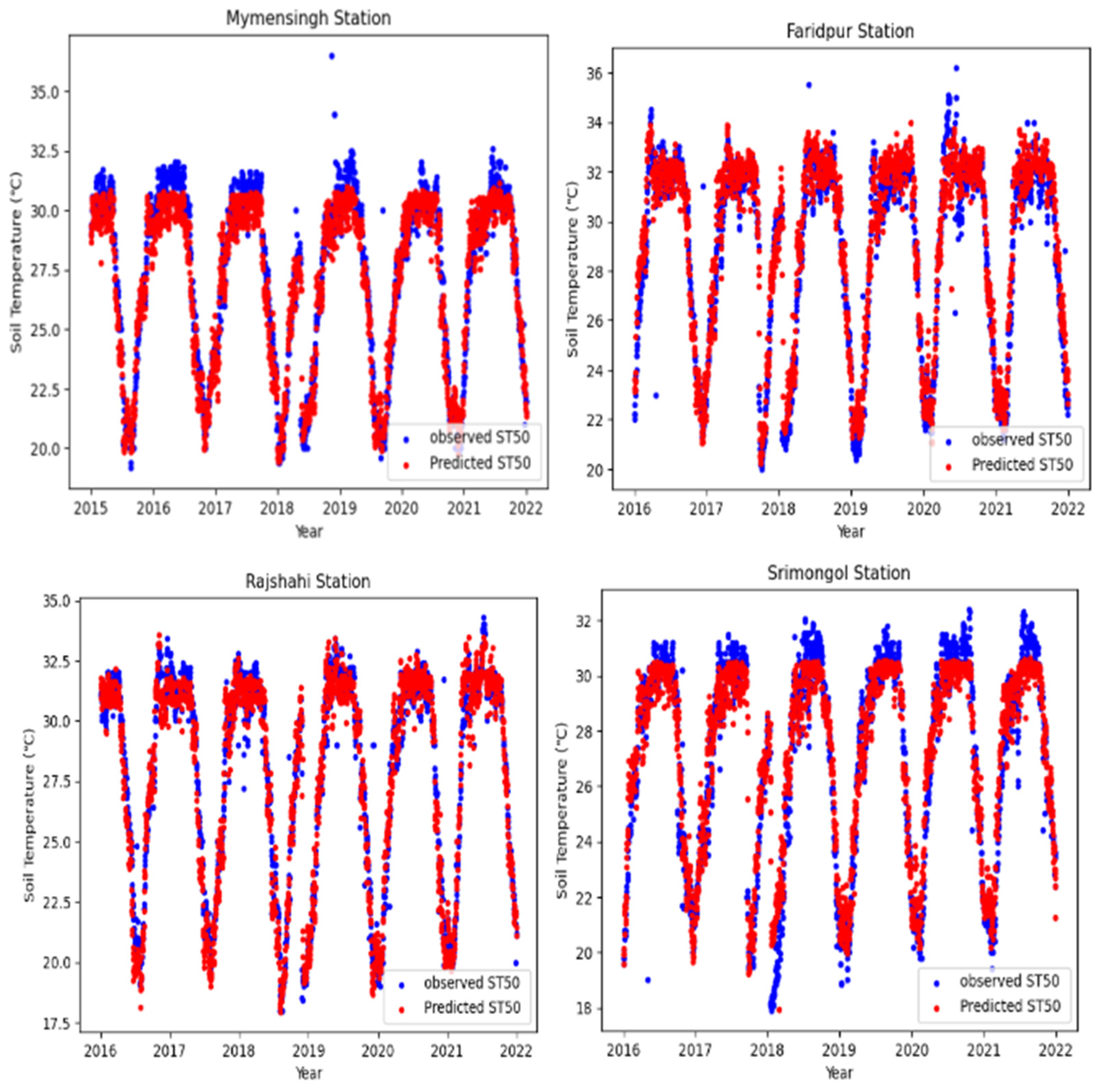
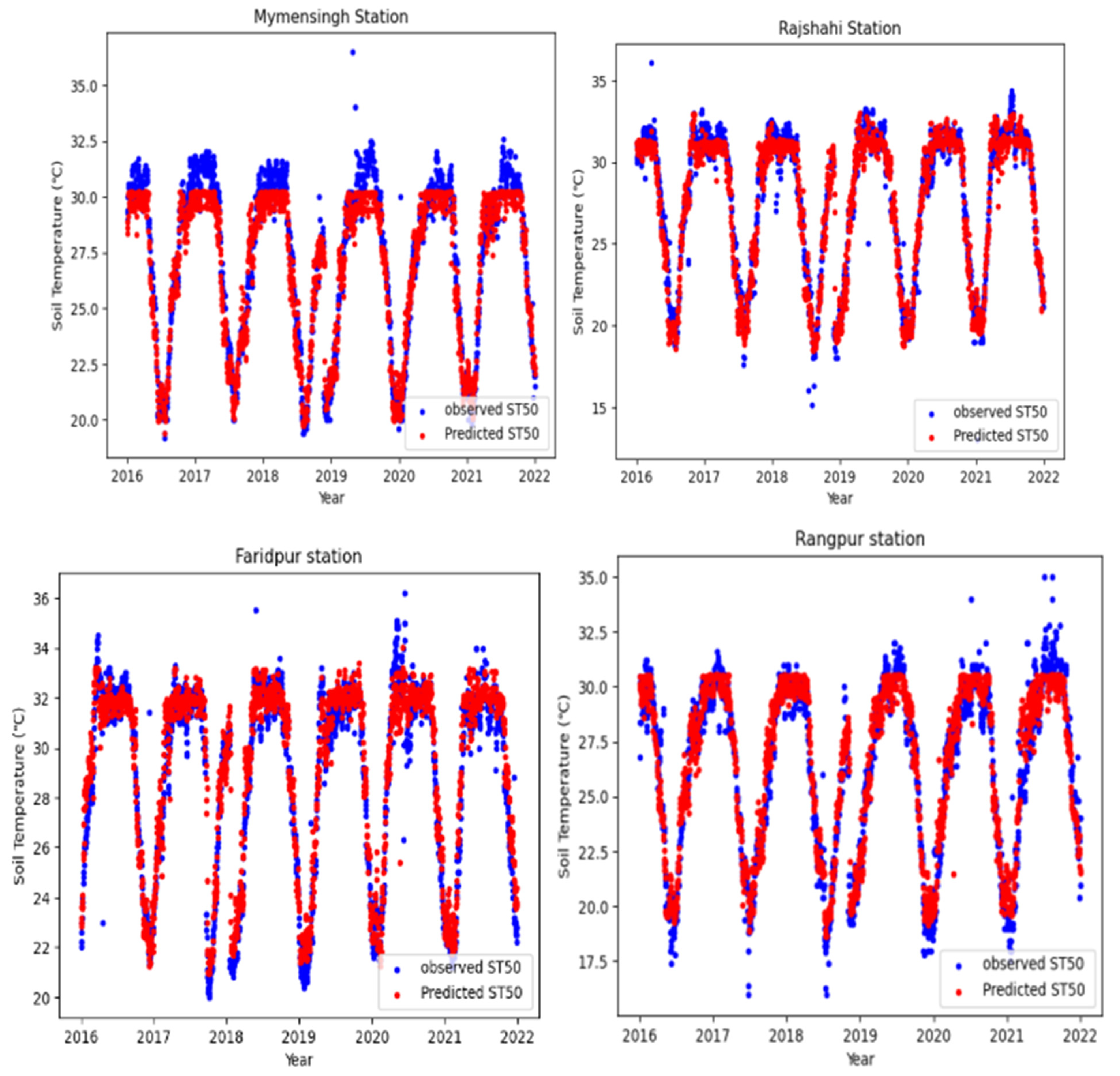
| Model | Time Window Size | One | Two | Three | Four | Five | |||||
|---|---|---|---|---|---|---|---|---|---|---|---|
| Scenarios | RMSE | R | RMSE | R | RMSE | R | RMSE | R | RMSE | R | |
| DT | MEAN | 1.620 | 0.936 | 1.552 | 0.941 | 1.520 | 0.944 | 1.502 | 0.945 | 1.490 | 0.946 |
| MEAN-SUN | 1.538 | 0.943 | 1.506 | 0.945 | 1.484 | 0.946 | 1.474 | 0.947 | 1.465 | 0.948 | |
| MEAN-MAX-MIN | 1.479 | 0.947 | 1.452 | 0.949 | 1.436 | 0.950 | 1.425 | 0.950 | 1.416 | 0.951 | |
| MEAN-HUM-RAIN | 1.490 | 0.946 | 1.466 | 0.948 | 1.451 | 0.949 | 1.443 | 0.949 | 1.436 | 0.949 | |
| MEAN-MAX-MIN-SUN | 1.471 | 0.947 | 1.448 | 0.949 | 1.433 | 0.950 | 1.422 | 0.951 | 1.414 | 0.951 | |
| MEAN-MAX-MIN-SUN-RAIN | 1.461 | 0.948 | 1.442 | 0.949 | 1.429 | 0.950 | 1.418 | 0.951 | 1.412 | 0.951 | |
| MEAN-MAX-MIN-SUN-HUM | 1.459 | 0.948 | 1.441 | 0.949 | 1.427 | 0.950 | 1.416 | 0.951 | 1.410 | 0.951 | |
| MEAN-MAX-MIN-SUN-HUM-RAIN | 1.454 | 0.949 | 1.439 | 0.950 | 1.425 | 0.950 | 1.415 | 0.951 | 1.409 | 0.952 | |
| RF | MEAN | 1.616 | 0.937 | 1.524 | 0.943 | 1.479 | 0.946 | 1.450 | 0.948 | 1.429 | 0.950 |
| MEAN-SUN | 1.509 | 0.945 | 1.446 | 0.949 | 1.414 | 0.951 | 1.393 | 0.952 | 1.379 | 0.953 | |
| MEAN-MAX-MIN | 1.440 | 0.949 | 1.390 | 0.953 | 1.361 | 0.954 | 1.342 | 0.956 | 1.329 | 0.956 | |
| MEAN-HUM-RAIN | 1.447 | 0.949 | 1.393 | 0.952 | 1.367 | 0.954 | 1.350 | 0.955 | 1.339 | 0.956 | |
| MEAN-MAX-MIN-SUN | 1.426 | 0.951 | 1.381 | 0.953 | 1.353 | 0.955 | 1.335 | 0.956 | 1.323 | 0.957 | |
| MEAN-MAX-MIN-SUN-RAIN | 1.413 | 0.951 | 1.373 | 0.954 | 1.347 | 0.955 | 1.330 | 0.956 | 1.318 | 0.957 | |
| MEAN-MAX-MIN-SUN-HUM | 1.404 | 0.952 | 1.365 | 0.954 | 1.340 | 0.956 | 1.323 | 0.957 | 1.312 | 0.958 | |
| MEAN-MAX-MIN-SUN-HUM-RAIN | 1.397 | 0.952 | 1.362 | 0.955 | 1.338 | 0.956 | 1.322 | 0.957 | 1.311 | 0.958 | |
| GBT | MEAN | 1.609 | 0.937 | 1.509 | 0.944 | 1.456 | 0.948 | 1.422 | 0.950 | 1.396 | 0.952 |
| MEAN-SUN | 1.489 | 0.946 | 1.407 | 0.952 | 1.360 | 0.955 | 1.330 | 0.956 | 1.306 | 0.958 | |
| MEAN-MAX-MIN | 1.407 | 0.952 | 1.340 | 0.956 | 1.302 | 0.958 | 1.274 | 0.960 | 1.255 | 0.961 | |
| MEAN-HUM-RAIN | 1.418 | 0.951 | 1.340 | 0.956 | 1.300 | 0.958 | 1.272 | 0.960 | 1.254 | 0.961 | |
| MEAN-MAX-MIN-SUN | 1.386 | 0.953 | 1.320 | 0.957 | 1.282 | 0.960 | 1.255 | 0.961 | 1.236 | 0.962 | |
| MEAN-MAX-MIN-SUN-RAIN | 1.367 | 0.954 | 1.308 | 0.958 | 1.272 | 0.960 | 1.245 | 0.962 | 1.227 | 0.963 | |
| MEAN-MAX-MIN-SUN-HUM | 1.350 | 0.955 | 1.288 | 0.959 | 1.253 | 0.961 | 1.226 | 0.963 | 1.208 | 0.964 | |
| MEAN-MAX-MIN-SUN-HUM-RAIN | 1.337 | 0.956 | 1.281 | 0.96 | 1.245 | 0.962 | 1.219 | 0.963 | 1.203 | 0.964 | |
| Hybrid DT-GBT | MEAN | 1.607 | 0.938 | 1.470 | 0.947 | 1.407 | 0.952 | 1.366 | 0.954 | 1.335 | 0.956 |
| MEAN-SUN | 1.446 | 0.950 | 1.346 | 0.956 | 1.295 | 0.959 | 1.262 | 0.961 | 1.238 | 0.962 | |
| MEAN-MAX-MIN | 1.355 | 0.955 | 1.276 | 0.960 | 1.234 | 0.963 | 1.207 | 0.964 | 1.187 | 0.965 | |
| MEAN-HUM-RAIN | 1.383 | 0.954 | 1.294 | 0.959 | 1.251 | 0.962 | 1.222 | 0.963 | 1.203 | 0.964 | |
| MEAN-MAX-MIN-SUN | 1.324 | 0.957 | 1.249 | 0.962 | 1.209 | 0.964 | 1.182 | 0.966 | 1.162 | 0.967 | |
| MEAN-MAX-MIN-SUN-RAIN | 1.309 | 0.958 | 1.241 | 0.962 | 1.203 | 0.965 | 1.175 | 0.966 | 1.157 | 0.967 | |
| MEAN-MAX-MIN-SUN-HUM | 1.289 | 0.960 | 1.223 | 0.963 | 1.185 | 0.966 | 1.159 | 0.967 | 1.143 | 0.968 | |
| MEAN-MAX-MIN-SUN-HUM-RAIN | 1.280 | 0.960 | 1.216 | 0.964 | 1.179 | 0.966 | 1.153 | 0.967 | 1.137 | 0.968 | |
| Hybrid RF-GBT | MEAN | 1.605 | 0.938 | 1.463 | 0.948 | 1.396 | 0.952 | 1.352 | 0.955 | 1.318 | 0.957 |
| MEAN-SUN | 1.438 | 0.950 | 1.329 | 0.957 | 1.274 | 0.960 | 1.238 | 0.963 | 1.212 | 0.964 | |
| MEAN-MAX-MIN | 1.344 | 0.956 | 1.258 | 0.961 | 1.212 | 0.964 | 1.182 | 0.966 | 1.161 | 0.967 | |
| MEAN-HUM-RAIN | 1.371 | 0.954 | 1.272 | 0.960 | 1.226 | 0.963 | 1.193 | 0.965 | 1.173 | 0.966 | |
| MEAN-MAX-MIN-SUN | 1.311 | 0.958 | 1.229 | 0.963 | 1.185 | 0.966 | 1.155 | 0.967 | 1.133 | 0.968 | |
| MEAN-MAX-MIN-SUN-RAIN | 1.295 | 0.959 | 1.220 | 0.964 | 1.178 | 0.966 | 1.147 | 0.968 | 1.127 | 0.969 | |
| MEAN-MAX-MIN-SUN-HUM | 1.273 | 0.960 | 1.199 | 0.965 | 1.158 | 0.967 | 1.129 | 0.969 | 1.111 | 0.970 | |
| MEAN-MAX-MIN-SUN-HUM-RAIN | 1.263 | 0.961 | 1.192 | 0.965 | 1.151 | 0.967 | 1.123 | 0.969 | 1.105 | 0.970 | |
| Model | Time Window Size | One | Two | Three | Four | Five | |||||
|---|---|---|---|---|---|---|---|---|---|---|---|
| Scenarios | RMSE | R | RMSE | R | RMSE | R | RMSE | R | RMSE | R | |
| DT | MEAN | 2.220 | 0.922 | 2.161 | 0.928 | 2.145 | 0.930 | 2.143 | 0.930 | 2.140 | 0.930 |
| MEAN-SUN | 2.192 | 0.925 | 2.161 | 0.929 | 2.147 | 0.930 | 2.142 | 0.930 | 2.136 | 0.930 | |
| MEAN-MAX-MIN | 2.126 | 0.932 | 2.105 | 0.934 | 2.096 | 0.935 | 2.088 | 0.936 | 2.086 | 0.936 | |
| MEAN-HUM-RAIN | 2.201 | 0.925 | 2.161 | 0.928 | 2.152 | 0.929 | 2.149 | 0.929 | 2.145 | 0.929 | |
| MEAN-MAX-MIN-SUN | 2.126 | 0.932 | 2.104 | 0.934 | 2.096 | 0.935 | 2.090 | 0.935 | 2.087 | 0.935 | |
| MEAN-MAX-MIN-SUN-RAIN | 2.128 | 0.932 | 2.108 | 0.934 | 2.099 | 0.935 | 2.094 | 0.935 | 2.090 | 0.934 | |
| MEAN-MAX-MIN-SUN-HUM | 2.132 | 0.931 | 2.112 | 0.933 | 2.103 | 0.934 | 2.093 | 0.935 | 2.087 | 0.935 | |
| MEAN-MAX-MIN-SUN-HUM-RAIN | 2.133 | 0.931 | 2.112 | 0.933 | 2.104 | 0.934 | 2.096 | 0.935 | 2.090 | 0.934 | |
| RF | MEAN | 2.212 | 0.923 | 2.128 | 0.932 | 2.097 | 0.934 | 2.085 | 0.936 | 2.073 | 0.937 |
| MEAN-SUN | 2.157 | 0.928 | 2.094 | 0.934 | 2.068 | 0.937 | 2.058 | 0.938 | 2.049 | 0.939 | |
| MEAN-MAX-MIN | 2.088 | 0.935 | 2.043 | 0.939 | 2.019 | 0.942 | 2.009 | 0.942 | 2.001 | 0.943 | |
| MEAN-HUM-RAIN | 2.158 | 0.928 | 2.086 | 0.935 | 2.060 | 0.937 | 2.051 | 0.938 | 2.042 | 0.939 | |
| MEAN-MAX-MIN-SUN | 2.080 | 0.936 | 2.036 | 0.940 | 2.014 | 0.942 | 2.004 | 0.942 | 1.997 | 0.943 | |
| MEAN-MAX-MIN-SUN-RAIN | 2.076 | 0.936 | 2.034 | 0.940 | 2.013 | 0.942 | 2.003 | 0.943 | 1.998 | 0.943 | |
| MEAN-MAX-MIN-SUN-HUM | 2.075 | 0.936 | 2.033 | 0.940 | 2.010 | 0.942 | 2.001 | 0.943 | 1.994 | 0.943 | |
| MEAN-MAX-MIN-SUN-HUM-RAIN | 2.072 | 0.936 | 2.031 | 0.940 | 2.011 | 0.942 | 2.002 | 0.942 | 1.994 | 0.944 | |
| GBT | MEAN | 2.215 | 0.923 | 2.134 | 0.931 | 2.098 | 0.934 | 2.084 | 0.936 | 2.072 | 0.937 |
| MEAN-SUN | 2.159 | 0.928 | 2.089 | 0.935 | 2.053 | 0.938 | 2.044 | 0.939 | 2.034 | 0.940 | |
| MEAN-MAX-MIN | 2.091 | 0.935 | 2.037 | 0.940 | 2.005 | 0.942 | 2.006 | 0.943 | 1.997 | 0.944 | |
| MEAN-HUM-RAIN | 2.157 | 0.928 | 2.075 | 0.938 | 2.039 | 0.939 | 2.032 | 0.940 | 2.022 | 0.941 | |
| MEAN-MAX-MIN-SUN | 2.078 | 0.936 | 2.027 | 0.940 | 1.996 | 0.943 | 1.994 | 0.944 | 1.987 | 0.944 | |
| MEAN-MAX-MIN-SUN-RAIN | 2.070 | 0.937 | 2.021 | 0.941 | 1.988 | 0.943 | 1.990 | 0.944 | 1.980 | 0.945 | |
| MEAN-MAX-MIN-SUN-HUM | 2.075 | 0.936 | 2.026 | 0.941 | 1.996 | 0.943 | 1.991 | 0.944 | 1.983 | 0.944 | |
| MEAN-MAX-MIN-SUN-HUM-RAIN | 2.067 | 0.937 | 2.017 | 0.941 | 1.986 | 0.943 | 1.985 | 0.944 | 1.976 | 0.945 | |
| Hybrid DT-GBT | MEAN | 2.219 | 0.923 | 2.146 | 0.930 | 2.103 | 0.933 | 2.105 | 0.934 | 2.095 | 0.927 |
| MEAN-SUN | 2.175 | 0.927 | 2.111 | 0.933 | 2.060 | 0.935 | 2.071 | 0.937 | 2.060 | 0.933 | |
| MEAN-MAX-MIN | 2.106 | 0.934 | 2.063 | 0.938 | 2.020 | 0.940 | 2.027 | 0.941 | 2.021 | 0.942 | |
| MEAN-HUM-RAIN | 2.172 | 0.927 | 2.093 | 0.934 | 2.044 | 0.936 | 2.058 | 0.937 | 2.050 | 0.935 | |
| MEAN-MAX-MIN-SUN | 2.098 | 0.934 | 2.052 | 0.938 | 2.008 | 0.940 | 2.020 | 0.941 | 2.013 | 0.942 | |
| MEAN-MAX-MIN-SUN-RAIN | 2.091 | 0.935 | 2.048 | 0.939 | 2.001 | 0.941 | 2.017 | 0.942 | 2.009 | 0.943 | |
| MEAN-MAX-MIN-SUN-HUM | 2.094 | 0.935 | 2.047 | 0.938 | 2.000 | 0.940 | 2.013 | 0.941 | 2.005 | 0.943 | |
| MEAN-MAX-MIN-SUN-HUM-RAIN | 2.086 | 0.935 | 2.042 | 0.939 | 1.994 | 0.941 | 2.012 | 0.941 | 2.002 | 0.944 | |
| Hybrid RF-GBT | MEAN | 2.216 | 0.923 | 2.158 | 0.931 | 2.102 | 0.934 | 2.086 | 0.936 | 2.074 | 0.929 |
| MEAN-SUN | 2.165 | 0.928 | 2.097 | 0.935 | 2.058 | 0.938 | 2.045 | 0.939 | 2.032 | 0.935 | |
| MEAN-MAX-MIN | 2.094 | 0.935 | 2.024 | 0.940 | 2.019 | 0.942 | 2.003 | 0.943 | 1.996 | 0.943 | |
| MEAN-HUM-RAIN | 2.159 | 0.928 | 2.058 | 0.936 | 2.042 | 0.939 | 2.027 | 0.940 | 2.020 | 0.937 | |
| MEAN-MAX-MIN-SUN | 2.083 | 0.935 | 2.015 | 0.940 | 2.007 | 0.942 | 1.993 | 0.943 | 1.987 | 0.944 | |
| MEAN-MAX-MIN-SUN-RAIN | 2.075 | 0.936 | 2.007 | 0.941 | 1.999 | 0.943 | 1.990 | 0.944 | 1.983 | 0.944 | |
| MEAN-MAX-MIN-SUN-HUM | 2.077 | 0.936 | 2.006 | 0.940 | 1.998 | 0.943 | 1.986 | 0.944 | 1.978 | 0.945 | |
| MEAN-MAX-MIN-SUN-HUM-RAIN | 2.067 | 0.937 | 2.000 | 0.941 | 1.992 | 0.943 | 1.982 | 0.944 | 1.973 | 0.945 | |
| Model | Time Window Size | One | Two | Three | Four | Five | |||||
|---|---|---|---|---|---|---|---|---|---|---|---|
| Scenarios | RMSE | R | RMSE | R | RMSE | R | RMSE | R | RMSE | R | |
| DT | MEAN | 1.946 | 0.910 | 1.920 | 0.912 | 1.905 | 0.913 | 1.89 | 0.914 | 1.887 | 0.915 |
| MEAN-SUN | 1.934 | 0.911 | 1.923 | 0.911 | 1.908 | 0.913 | 1.893 | 0.914 | 1.886 | 0.914 | |
| MEAN-MAX-MIN | 1.885 | 0.915 | 1.872 | 0.916 | 1.866 | 0.916 | 1.851 | 0.917 | 1.849 | 0.918 | |
| MEAN-HUM-RAIN | 1.920 | 0.911 | 1.908 | 0.912 | 1.896 | 0.913 | 1.881 | 0.914 | 1.876 | 0.915 | |
| MEAN-MAX-MIN-SUN | 1.893 | 0.914 | 1.874 | 0.916 | 1.869 | 0.916 | 1.856 | 0.917 | 1.853 | 0.917 | |
| MEAN-MAX-MIN-SUN-RAIN | 1.886 | 0.915 | 1.873 | 0.916 | 1.868 | 0.916 | 1.859 | 0.916 | 1.853 | 0.917 | |
| MEAN-MAX-MIN-SUN-HUM | 1.901 | 0.913 | 1.886 | 0.914 | 1.878 | 0.915 | 1.862 | 0.916 | 1.857 | 0.916 | |
| MEAN-MAX-MIN-SUN-HUM-RAIN | 1.897 | 0.913 | 1.886 | 0.914 | 1.877 | 0.915 | 1.864 | 0.916 | 1.858 | 0.916 | |
| RF | MEAN | 1.939 | 0.910 | 1.893 | 0.914 | 1.864 | 0.917 | 1.843 | 0.918 | 1.829 | 0.920 |
| MEAN-SUN | 1.902 | 0.914 | 1.864 | 0.917 | 1.841 | 0.919 | 1.820 | 0.920 | 1.808 | 0.922 | |
| MEAN-MAX-MIN | 1.845 | 0.919 | 1.811 | 0.921 | 1.791 | 0.923 | 1.773 | 0.924 | 1.763 | 0.925 | |
| MEAN-HUM-RAIN | 1.867 | 0.916 | 1.830 | 0.919 | 1.810 | 0.921 | 1.794 | 0.922 | 1.785 | 0.923 | |
| MEAN-MAX-MIN-SUN | 1.841 | 0.919 | 1.808 | 0.922 | 1.790 | 0.923 | 1.773 | 0.924 | 1.763 | 0.925 | |
| MEAN-MAX-MIN-SUN-RAIN | 1.829 | 0.920 | 1.800 | 0.922 | 1.783 | 0.924 | 1.768 | 0.925 | 1.759 | 0.926 | |
| MEAN-MAX-MIN-SUN-HUM | 1.833 | 0.919 | 1.807 | 0.922 | 1.788 | 0.923 | 1.772 | 0.924 | 1.762 | 0.925 | |
| MEAN-MAX-MIN-SUN-HUM-RAIN | 1.826 | 0.920 | 1.802 | 0.922 | 1.784 | 0.923 | 1.769 | 0.925 | 1.760 | 0.925 | |
| GBT | MEAN | 1.941 | 0.910 | 1.902 | 0.914 | 1.873 | 0.916 | 1.852 | 0.917 | 1.836 | 0.919 |
| MEAN-SUN | 1.910 | 0.913 | 1.876 | 0.917 | 1.843 | 0.919 | 1.822 | 0.920 | 1.808 | 0.922 | |
| MEAN-MAX-MIN | 1.858 | 0.917 | 1.815 | 0.921 | 1.800 | 0.922 | 1.781 | 0.923 | 1.773 | 0.924 | |
| MEAN-HUM-RAIN | 1.871 | 0.916 | 1.827 | 0.920 | 1.804 | 0.921 | 1.790 | 0.922 | 1.776 | 0.924 | |
| MEAN-MAX-MIN-SUN | 1.846 | 0.918 | 1.811 | 0.921 | 1.793 | 0.923 | 1.774 | 0.924 | 1.768 | 0.925 | |
| MEAN-MAX-MIN-SUN-RAIN | 1.828 | 0.920 | 1.797 | 0.922 | 1.775 | 0.924 | 1.763 | 0.925 | 1.756 | 0.926 | |
| MEAN-MAX-MIN-SUN-HUM | 1.838 | 0.919 | 1.806 | 0.922 | 1.790 | 0.923 | 1.771 | 0.925 | 1.765 | 0.925 | |
| MEAN-MAX-MIN-SUN-HUM-RAIN | 1.825 | 0.920 | 1.796 | 0.923 | 1.779 | 0.924 | 1.762 | 0.925 | 1.755 | 0.926 | |
| Hybrid DT-GBT | MEAN | 1.947 | 0.910 | 1.913 | 0.913 | 1.886 | 0.914 | 1.864 | 0.917 | 1.855 | 0.917 |
| MEAN-SUN | 1.922 | 0.912 | 1.910 | 0.914 | 1.866 | 0.916 | 1.843 | 0.918 | 1.830 | 0.919 | |
| MEAN-MAX-MIN | 1.868 | 0.916 | 1.839 | 0.919 | 1.820 | 0.921 | 1.800 | 0.922 | 1.796 | 0.922 | |
| MEAN-HUM-RAIN | 1.891 | 0.914 | 1.852 | 0.917 | 1.828 | 0.919 | 1.810 | 0.921 | 1.802 | 0.921 | |
| MEAN-MAX-MIN-SUN | 1.866 | 0.916 | 1.837 | 0.919 | 1.820 | 0.920 | 1.802 | 0.922 | 1.794 | 0.922 | |
| MEAN-MAX-MIN-SUN-RAIN | 1.851 | 0.918 | 1.819 | 0.920 | 1.805 | 0.921 | 1.797 | 0.922 | 1.782 | 0.923 | |
| MEAN-MAX-MIN-SUN-HUM | 1.865 | 0.916 | 1.835 | 0.919 | 1.818 | 0.920 | 1.797 | 0.922 | 1.790 | 0.923 | |
| MEAN-MAX-MIN-SUN-HUM-RAIN | 1.852 | 0.917 | 1.825 | 0.920 | 1.807 | 0.921 | 1.792 | 0.922 | 1.782 | 0.923 | |
| Hybrid RF-GBT | MEAN | 1.944 | 0.910 | 1.905 | 0.919 | 1.874 | 0.916 | 1.850 | 0.918 | 1.837 | 0.919 |
| MEAN-SUN | 1.913 | 0.912 | 1.900 | 0.915 | 1.845 | 0.918 | 1.821 | 0.920 | 1.806 | 0.921 | |
| MEAN-MAX-MIN | 1.856 | 0.917 | 1.819 | 0.922 | 1.796 | 0.922 | 1.776 | 0.924 | 1.768 | 0.925 | |
| MEAN-HUM-RAIN | 1.874 | 0.915 | 1.827 | 0.921 | 1.801 | 0.921 | 1.784 | 0.923 | 1.774 | 0.924 | |
| MEAN-MAX-MIN-SUN | 1.850 | 0.918 | 1.817 | 0.921 | 1.795 | 0.922 | 1.777 | 0.924 | 1.766 | 0.925 | |
| MEAN-MAX-MIN-SUN-RAIN | 1.834 | 0.919 | 1.797 | 0.922 | 1.779 | 0.924 | 1.768 | 0.925 | 1.753 | 0.926 | |
| MEAN-MAX-MIN-SUN-HUM | 1.843 | 0.918 | 1.810 | 0.922 | 1.791 | 0.923 | 1.77 | 0.924 | 1.761 | 0.925 | |
| MEAN-MAX-MIN-SUN-HUM-RAIN | 1.829 | 0.919 | 1.797 | 0.922 | 1.777 | 0.924 | 1.762 | 0.925 | 1.752 | 0.927 | |
| Model | Time Window Size | One | Two | Three | Four | Five | |||||
|---|---|---|---|---|---|---|---|---|---|---|---|
| Scenarios | RMSE | R | RMSE | R | RMSE | R | RMSE | R | RMSE | R | |
| DT | MEAN | 1.623 | 0.926 | 1.516 | 0.936 | 1.460 | 0.941 | 1.440 | 0.943 | 1.420 | 0.945 |
| MEAN-SUN | 1.595 | 0.929 | 1.504 | 0.938 | 1.458 | 0.941 | 1.438 | 0.943 | 1.415 | 0.945 | |
| MEAN-MAX-MIN | 1.480 | 0.938 | 1.413 | 0.944 | 1.378 | 0.947 | 1.361 | 0.949 | 1.349 | 0.950 | |
| MEAN-HUM-RAIN | 1.565 | 0.931 | 1.475 | 0.939 | 1.442 | 0.942 | 1.428 | 0.944 | 1.410 | 0.945 | |
| MEAN-MAX-MIN-SUN | 1.477 | 0.939 | 1.414 | 0.944 | 1.378 | 0.947 | 1.363 | 0.948 | 1.350 | 0.949 | |
| MEAN-MAX-MIN-SUN-RAIN | 1.471 | 0.939 | 1.413 | 0.944 | 1.38 | 0.947 | 1.364 | 0.948 | 1.350 | 0.949 | |
| MEAN-MAX-MIN-SUN-HUM | 1.480 | 0.938 | 1.414 | 0.944 | 1.381 | 0.947 | 1.365 | 0.948 | 1.351 | 0.949 | |
| MEAN-MAX-MIN-SUN-HUM-RAIN | 1.475 | 0.938 | 1.412 | 0.944 | 1.381 | 0.947 | 1.366 | 0.948 | 1.354 | 0.949 | |
| RF | MEAN | 1.620 | 0.926 | 1.476 | 0.94 | 1.400 | 0.946 | 1.360 | 0.950 | 1.329 | 0.953 |
| MEAN-SUN | 1.566 | 0.932 | 1.439 | 0.943 | 1.373 | 0.949 | 1.338 | 0.952 | 1.310 | 0.955 | |
| MEAN-MAX-MIN | 1.442 | 0.942 | 1.341 | 0.95 | 1.285 | 0.955 | 1.254 | 0.957 | 1.234 | 0.957 | |
| MEAN-HUM-RAIN | 1.516 | 0.935 | 1.385 | 0.947 | 1.325 | 0.952 | 1.293 | 0.955 | 1.271 | 0.957 | |
| MEAN-MAX-MIN-SUN | 1.437 | 0.942 | 1.337 | 0.950 | 1.282 | 0.955 | 1.252 | 0.957 | 1.233 | 0.957 | |
| MEAN-MAX-MIN-SUN-RAIN | 1.427 | 0.943 | 1.331 | 0.951 | 1.279 | 0.955 | 1.250 | 0.957 | 1.231 | 0.957 | |
| MEAN-MAX-MIN-SUN-HUM | 1.422 | 0.943 | 1.325 | 0.951 | 1.273 | 0.955 | 1.244 | 0.958 | 1.226 | 0.958 | |
| MEAN-MAX-MIN-SUN-HUM-RAIN | 1.415 | 0.944 | 1.321 | 0.952 | 1.271 | 0.956 | 1.243 | 0.958 | 1.225 | 0.959 | |
| GBT | MEAN | 1.622 | 0.926 | 1.479 | 0.940 | 1.405 | 0.946 | 1.362 | 0.950 | 1.330 | 0.953 |
| MEAN-SUN | 1.566 | 0.932 | 1.441 | 0.944 | 1.374 | 0.949 | 1.335 | 0.952 | 1.303 | 0.955 | |
| MEAN-MAX-MIN | 1.444 | 0.941 | 1.346 | 0.95 | 1.285 | 0.955 | 1.252 | 0.958 | 1.229 | 0.960 | |
| MEAN-HUM-RAIN | 1.513 | 0.935 | 1.375 | 0.948 | 1.311 | 0.953 | 1.274 | 0.957 | 1.249 | 0.958 | |
| MEAN-MAX-MIN-SUN | 1.431 | 0.942 | 1.331 | 0.951 | 1.274 | 0.955 | 1.244 | 0.958 | 1.219 | 0.960 | |
| MEAN-MAX-MIN-SUN-RAIN | 1.419 | 0.943 | 1.319 | 0.952 | 1.264 | 0.956 | 1.233 | 0.959 | 1.210 | 0.960 | |
| MEAN-MAX-MIN-SUN-HUM | 1.414 | 0.943 | 1.315 | 0.952 | 1.256 | 0.956 | 1.223 | 0.959 | 1.198 | 0.961 | |
| MEAN-MAX-MIN-SUN-HUM-RAIN | 1.404 | 0.944 | 1.305 | 0.952 | 1.246 | 0.957 | 1.215 | 0.959 | 1.193 | 0.961 | |
| Hybrid DT-GBT | MEAN | 1.625 | 0.926 | 1.494 | 0.938 | 1.418 | 0.945 | 1.340 | 0.952 | 1.353 | 0.950 |
| MEAN-SUN | 1.580 | 0.931 | 1.453 | 0.942 | 1.386 | 0.948 | 1.324 | 0.953 | 1.323 | 0.952 | |
| MEAN-MAX-MIN | 1.453 | 0.941 | 1.357 | 0.949 | 1.302 | 0.954 | 1.247 | 0.958 | 1.253 | 0.957 | |
| MEAN-HUM-RAIN | 1.528 | 0.934 | 1.396 | 0.946 | 1.338 | 0.951 | 1.282 | 0.955 | 1.284 | 0.955 | |
| MEAN-MAX-MIN-SUN | 1.446 | 0.941 | 1.351 | 0.949 | 1.298 | 0.953 | 1.241 | 0.957 | 1.244 | 0.957 | |
| MEAN-MAX-MIN-SUN-RAIN | 1.431 | 0.942 | 1.341 | 0.95 | 1.288 | 0.954 | 1.237 | 0.958 | 1.239 | 0.958 | |
| MEAN-MAX-MIN-SUN-HUM | 1.427 | 0.942 | 1.334 | 0.950 | 1.280 | 0.954 | 1.229 | 0.958 | 1.230 | 0.958 | |
| MEAN-MAX-MIN-SUN-HUM-RAIN | 1.415 | 0.943 | 1.323 | 0.951 | 1.273 | 0.955 | 1.223 | 0.959 | 1.227 | 0.958 | |
| Hybrid RF-GBT | MEAN | 1.624 | 0.926 | 1.481 | 0.939 | 1.401 | 0.947 | 1.358 | 0.95 | 1.326 | 0.953 |
| MEAN-SUN | 1.571 | 0.932 | 1.434 | 0.944 | 1.361 | 0.95 | 1.324 | 0.953 | 1.293 | 0.955 | |
| MEAN-MAX-MIN | 1.442 | 0.941 | 1.335 | 0.951 | 1.276 | 0.956 | 1.241 | 0.958 | 1.219 | 0.960 | |
| MEAN-HUM-RAIN | 1.513 | 0.935 | 1.369 | 0.948 | 1.302 | 0.954 | 1.264 | 0.957 | 1.242 | 0.959 | |
| MEAN-MAX-MIN-SUN | 1.436 | 0.942 | 1.328 | 0.951 | 1.269 | 0.955 | 1.234 | 0.958 | 1.210 | 0.960 | |
| MEAN-MAX-MIN-SUN-RAIN | 1.419 | 0.943 | 1.315 | 0.952 | 1.257 | 0.956 | 1.227 | 0.959 | 1.203 | 0.961 | |
| MEAN-MAX-MIN-SUN-HUM | 1.411 | 0.944 | 1.306 | 0.952 | 1.248 | 0.957 | 1.216 | 0.959 | 1.192 | 0.961 | |
| MEAN-MAX-MIN-SUN-HUM-RAIN | 1.397 | 0.945 | 1.295 | 0.953 | 1.241 | 0.957 | 1.210 | 0.960 | 1.188 | 0.962 | |
| Model | Time Window Size | One | Two | Three | Four | Five | |||||
|---|---|---|---|---|---|---|---|---|---|---|---|
| Scenarios | RMSE | R | RMSE | R | RMSE | R | RMSE | R | RMSE | R | |
| DT | MEAN | 2.283 | 0.895 | 2.196 | 0.907 | 2.137 | 0.914 | 2.106 | 0.917 | 2.083 | 0.920 |
| MEAN-SUN | 2.260 | 0.899 | 2.200 | 0.905 | 2.148 | 0.912 | 2.131 | 0.915 | 2.105 | 0.918 | |
| MEAN-MAX-MIN | 2.139 | 0.910 | 2.071 | 0.917 | 2.037 | 0.922 | 2.015 | 0.924 | 2.001 | 0.926 | |
| MEAN-HUM-RAIN | 2.209 | 0.903 | 2.152 | 0.912 | 2.108 | 0.917 | 2.089 | 0.918 | 2.077 | 0.920 | |
| MEAN-MAX-MIN-SUN | 2.147 | 0.911 | 2.093 | 0.917 | 2.058 | 0.921 | 2.042 | 0.923 | 2.016 | 0.926 | |
| MEAN-MAX-MIN-SUN-RAIN | 2.141 | 0.911 | 2.091 | 0.917 | 2.056 | 0.921 | 2.040 | 0.923 | 2.018 | 0.926 | |
| MEAN-MAX-MIN-SUN-HUM | 2.139 | 0.912 | 2.093 | 0.917 | 2.055 | 0.921 | 2.036 | 0.924 | 2.019 | 0.926 | |
| MEAN-MAX-MIN-SUN-HUM-RAIN | 2.142 | 0.911 | 2.094 | 0.917 | 2.056 | 0.921 | 2.038 | 0.923 | 2.019 | 0.926 | |
| RF | MEAN | 2.277 | 0.896 | 2.168 | 0.911 | 2.091 | 0.920 | 2.043 | 0.926 | 2.008 | 0.929 |
| MEAN-SUN | 2.230 | 0.904 | 2.141 | 0.915 | 2.076 | 0.923 | 2.035 | 0.928 | 2.005 | 0.931 | |
| MEAN-MAX-MIN | 2.101 | 0.917 | 2.014 | 0.927 | 1.957 | 0.933 | 1.919 | 0.937 | 1.893 | 0.940 | |
| MEAN-HUM-RAIN | 2.174 | 0.910 | 2.076 | 0.922 | 2.009 | 0.929 | 1.969 | 0.933 | 1.941 | 0.936 | |
| MEAN-MAX-MIN-SUN | 2.102 | 0.917 | 2.020 | 0.927 | 1.967 | 0.933 | 1.932 | 0.937 | 1.906 | 0.940 | |
| MEAN-MAX-MIN-SUN-RAIN | 2.094 | 0.918 | 2.017 | 0.928 | 1.964 | 0.933 | 1.931 | 0.937 | 1.904 | 0.940 | |
| MEAN-MAX-MIN-SUN-HUM | 2.085 | 0.920 | 2.007 | 0.929 | 1.956 | 0.935 | 1.922 | 0.938 | 1.896 | 0.941 | |
| MEAN-MAX-MIN-SUN-HUM-RAIN | 2.079 | 0.920 | 2.004 | 0.929 | 1.956 | 0.935 | 1.921 | 0.938 | 1.896 | 0.941 | |
| GBT | MEAN | 2.277 | 0.896 | 2.167 | 0.910 | 2.091 | 0.920 | 2.044 | 0.925 | 2.006 | 0.930 |
| MEAN-SUN | 2.229 | 0.904 | 2.137 | 0.915 | 2.079 | 0.923 | 2.039 | 0.928 | 2.007 | 0.931 | |
| MEAN-MAX-MIN | 2.109 | 0.916 | 2.023 | 0.925 | 1.962 | 0.932 | 1.926 | 0.936 | 1.897 | 0.939 | |
| MEAN-HUM-RAIN | 2.178 | 0.909 | 2.061 | 0.923 | 2.001 | 0.93 | 1.958 | 0.934 | 1.922 | 0.938 | |
| MEAN-MAX-MIN-SUN | 2.105 | 0.916 | 2.024 | 0.926 | 1.969 | 0.932 | 1.937 | 0.936 | 1.908 | 0.939 | |
| MEAN-MAX-MIN-SUN-RAIN | 2.095 | 0.918 | 2.016 | 0.927 | 1.962 | 0.933 | 1.931 | 0.937 | 1.904 | 0.940 | |
| MEAN-MAX-MIN-SUN-HUM | 2.102 | 0.918 | 2.032 | 0.927 | 1.977 | 0.933 | 1.943 | 0.937 | 1.913 | 0.940 | |
| MEAN-MAX-MIN-SUN-HUM-RAIN | 2.091 | 0.919 | 2.017 | 0.928 | 1.966 | 0.934 | 1.934 | 0.938 | 1.907 | 0.941 | |
| Hybrid DT-GBT | MEAN | 2.283 | 0.895 | 2.179 | 0.908 | 2.105 | 0.917 | 2.057 | 0.923 | 2.025 | 0.926 |
| MEAN-SUN | 2.246 | 0.901 | 2.152 | 0.912 | 2.089 | 0.920 | 2.056 | 0.925 | 2.022 | 0.929 | |
| MEAN-MAX-MIN | 2.121 | 0.913 | 2.033 | 0.923 | 1.978 | 0.929 | 1.945 | 0.933 | 1.920 | 0.936 | |
| MEAN-HUM-RAIN | 2.186 | 0.907 | 2.083 | 0.920 | 2.018 | 0.926 | 1.981 | 0.930 | 1.957 | 0.933 | |
| MEAN-MAX-MIN-SUN | 2.125 | 0.914 | 2.045 | 0.923 | 1.992 | 0.929 | 1.958 | 0.933 | 1.930 | 0.936 | |
| MEAN-MAX-MIN-SUN-RAIN | 2.115 | 0.915 | 2.036 | 0.924 | 1.984 | 0.930 | 1.958 | 0.933 | 1.928 | 0.936 | |
| MEAN-MAX-MIN-SUN-HUM | 2.108 | 0.917 | 2.037 | 0.925 | 1.984 | 0.931 | 1.954 | 0.934 | 1.928 | 0.936 | |
| MEAN-MAX-MIN-SUN-HUM-RAIN | 2.103 | 0.916 | 2.028 | 0.926 | 1.977 | 0.931 | 1.949 | 0.934 | 1.925 | 0.937 | |
| Hybrid RF-GBT | MEAN | 2.281 | 0.895 | 2.171 | 0.910 | 2.091 | 0.919 | 2.039 | 0.925 | 2.004 | 0.929 |
| MEAN-SUN | 2.235 | 0.903 | 2.136 | 0.915 | 2.070 | 0.923 | 2.027 | 0.928 | 1.994 | 0.932 | |
| MEAN-MAX-MIN | 2.108 | 0.915 | 2.017 | 0.926 | 1.954 | 0.932 | 1.917 | 0.937 | 1.889 | 0.940 | |
| MEAN-HUM-RAIN | 2.176 | 0.909 | 2.060 | 0.923 | 1.988 | 0.930 | 1.946 | 0.934 | 1.916 | 0.938 | |
| MEAN-MAX-MIN-SUN | 2.112 | 0.916 | 2.023 | 0.926 | 1.963 | 0.932 | 1.926 | 0.936 | 1.898 | 0.940 | |
| MEAN-MAX-MIN-SUN-RAIN | 2.101 | 0.917 | 2.013 | 0.927 | 1.956 | 0.934 | 1.923 | 0.937 | 1.894 | 0.940 | |
| MEAN-MAX-MIN-SUN-HUM | 2.093 | 0.919 | 2.010 | 0.928 | 1.955 | 0.934 | 1.920 | 0.938 | 1.893 | 0.941 | |
| MEAN-MAX-MIN-SUN-HUM-RAIN | 2.084 | 0.919 | 2.000 | 0.929 | 1.946 | 0.935 | 1.914 | 0.938 | 1.888 | 0.942 | |
| Soil Depth | Lead Time | Input Scenario + Time Window Size + Model | RMSE (°C) | R | ||
|---|---|---|---|---|---|---|
| 10 cm | One-day | 8th | Five-day | Hybrid RF-GBT | 1.973 | 0.945 |
| Three-day | 8th | Five-day | Hybrid RF-GBT | 1.752 | 0.927 | |
| Five-day | 8th | Four-day | Hybrid RF-GBT | 1.908 | 0.911 | |
| 30 cm | One-day | 8th | Five-day | Hybrid RF-GBT | 1.188 | 0.962 |
| Three-day | 8th | Five-day | Hybrid RF-GBT | 1.260 | 0.956 | |
| Five-day | 8th | Five-day | Hybrid RF-GBT | 1.398 | 0.945 | |
| 50 cm | One-day | 8th | Five-day | Hybrid RF-GBT | 1.888 | 0.942 |
| Three-day | 3rd | Five-day | Hybrid RF-GBT | 1.901 | 0.939 | |
| 8th | Five-day | Hybrid RF-GBT | 1.905 | 0.940 | ||
| Five-day | 3rd | Five-day | RF | 1.962 | 0.933 | |
| 8th | Five-day | RF | 1.971 | 0.935 | ||
Disclaimer/Publisher’s Note: The statements, opinions and data contained in all publications are solely those of the individual author(s) and contributor(s) and not of MDPI and/or the editor(s). MDPI and/or the editor(s) disclaim responsibility for any injury to people or property resulting from any ideas, methods, instructions or products referred to in the content. |
© 2023 by the authors. Licensee MDPI, Basel, Switzerland. This article is an open access article distributed under the terms and conditions of the Creative Commons Attribution (CC BY) license (https://creativecommons.org/licenses/by/4.0/).
Share and Cite
Das, L.C.; Zhang, Z.; Crabbe, M.J.C. Optimization of Data-Driven Soil Temperature Forecast—The First Model in Bangladesh. Appl. Sci. 2023, 13, 12616. https://doi.org/10.3390/app132312616
Das LC, Zhang Z, Crabbe MJC. Optimization of Data-Driven Soil Temperature Forecast—The First Model in Bangladesh. Applied Sciences. 2023; 13(23):12616. https://doi.org/10.3390/app132312616
Chicago/Turabian StyleDas, Lipon Chandra, Zhihua Zhang, and M. James C. Crabbe. 2023. "Optimization of Data-Driven Soil Temperature Forecast—The First Model in Bangladesh" Applied Sciences 13, no. 23: 12616. https://doi.org/10.3390/app132312616
APA StyleDas, L. C., Zhang, Z., & Crabbe, M. J. C. (2023). Optimization of Data-Driven Soil Temperature Forecast—The First Model in Bangladesh. Applied Sciences, 13(23), 12616. https://doi.org/10.3390/app132312616








